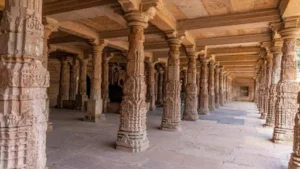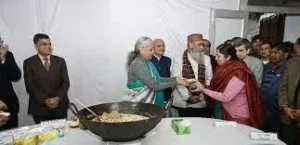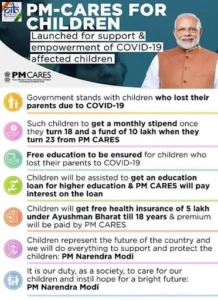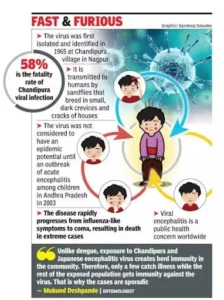UPSC GS 1
Bhojshala Complex
- News: The existing structure at the Bhojshala complex in Madhya Pradesh’s Dhar district has been constructed using remains of a temple that existed earlier at the site.
- About Bhojshala Complex:
-
- The Bhojshala Complex is located in the Dhar district of Madhya Pradesh.
- It was built in 1034 AD by Raja Bhoja (1000-1055 AD), the greatest monarch of the Paramara dynasty.
- The complex served as a university, attracting students to study music, Sanskrit, astronomy, yoga, Ayurveda, and philosophy.
-

- History:
-
- The complex was first attacked by Alauddin Khilji in 1305 AD.
- In 1514 AD, Mehmudshah Khilji II attacked the complex again and attempted to convert it into a dargah. He encroached on land outside the Saraswati Temple and built the ‘Kamal Moulana’ Makbara.
-
- Inscriptions Found:
-
- The rocks of the complex contain two hymns written in the Prakrit language, dedicated to the Karmavatar or crocodile incarnation of Vishnu.
- Two Sarpabandha pillar inscriptions are present, one containing the Sanskrit alphabet and the main endings of nouns and verbs, and the other containing the individual declensions of the ten tenses and moods of Sanskrit grammar.
-
- National Importance:
-
- In 1951, the Bhojshala Complex was declared a monument of national importance under the Ancient and Historical Monument and Archaeological Sites and Remains (Declaration of National Importance) Act, 1951.
- It is currently protected by the Archaeological Survey of India (ASI) under the Ancient Monuments and Archaeological Sites and Remains Act, 1958.
-
Read also: Karnataka’s Local Reservation Bill: A Comprehensive Review | UPSC
UPSC GS 2
Halwa Ceremony
- News: Finance Minister Nirmala Sitharaman recently participated in a traditional ‘halwa’ ceremony, marking the final stage for preparation of Union Budget 2024-25.
- Halwa Ceremony:
-
- The ceremony is a ritual in which traditional dessert ‘halwa’ is prepared and served to officials and staff members of the finance ministry who are involved in the preparation of the budget.
- It is organised in the basement of North Block, which houses the ministry in the national capital and is attended by the finance minister and other high-ranking officials.
- It is a kind of a ‘send-off’ for finance ministry officials and staff involved in the preparation of the Union government’s annual financial statement.
- They enter what is called a ‘lock-in’ period, during which they stay in the basement of North Block, cut off from the world outside with a view to maintaining the secrecy around the final budget document.
- They will emerge only after the finance minister completes her Budget speech in the Lok Sabha.
- It is considered a gesture of appreciation for those who have worked on the Budget.
-

- Background and Security Measures:
-
- These stringent measures trace back to a leak that occurred in 1950.
- A segment of the 1950 Union Budget was leaked when the printing of the Budget document was underway at Rashtrapati Bhawan.
- Following the leak, then finance minister John Matthai had to resign.
- Since 1980, the North Block basement has been established as the permanent location for budget printing.
-
PM Cares Scheme
- News: 51% of applications under PM Cares scheme for Covid orphans have been rejected.
- Aim: Launched in 2022 by Central Govt. to support children who have lost both parents or surviving parent or legal guardian or adoptive parents due to COVID-19 pandemic.
- Eligibility:
-
- All children who have lost i) Both parents or ii) Surviving parent or iii) legal guardian/adoptive parents/single adoptive parent due to COVID 19 pandemic.
- Child should not have completed 18 years of age on the date of death of parents.
-
- Nodal Ministry: Ministry of Women and Child Development
- Benefits:
- Support for Boarding and Lodging:
-
- Efforts will be made by the DM with the assistance of Child Welfare Committee to explore the possibility of rehabilitating the child within her/his extended family.
-
- Assistance for Pre-school and School Education:
-
- For children below 6 years of age:
- Identified beneficiaries will receive support and assistance from the Anganwadi services for supplementary nutrition, pre-school education, immunization, health referrals, and health check-up.
- For children below 10 years of age:
- The child will be given admission in the nearest Kendriya Vidyalaya or in a private school as a day scholar.
- If the child is admitted in a private school, the fees as per the RTE norms will be given from the PM CARES.
- PM-CARES will also pay for expenditure on uniform, text books and notebooks.
-
- Assistance for Higher Education:
-
- The child will be assisted in obtaining education loan for Professional courses /Higher Education in India
- Where beneficiary is unable to avail interest exemption from extant Central and State Government scheme, then the interest on the educational loan will be paid from PM CARES for Children Scheme.
-
- Health Insurance:
-
- All children will be enrolled as a beneficiary under Ayushman Bharat Scheme (PM-JAY) with a health insurance cover of Rs. 5 lakhs.
-

- Financial Support:
-
- A pro-rata amount will be credited in the account of each identified beneficiary such that the corpus for each beneficiary becomes Rs. 10 lakhs at the time of attaining 18 years of age.
- Children will receive monthly stipend once they attain 18 years by investing the corpus of Rs 10 lakhs.
- The beneficiary will receive stipend till they attain 23 years of age.
- They will receive an amount of Rs. 10 lakh on attaining 23 years of age.
-
UPSC GS 3
Late Blight Disease
- News: The Central Potato Research Institute has issued an advisory for potato farmers across the country, warning of a high risk of late blight disease in the crop due to changes in weather conditions.
- About Late Blight Disease: Late blight, caused by the fungus Phytophthora infestans, is a severe disease that affects tomatoes and potatoes.
- Transmission:
-
- The disease spreads through infected transplants, volunteer potato or tomato plants, and certain weeds related to tomatoes.
- Spores of the fungus can become airborne and travel long distances during storms, with rain depositing spores on plants and causing infection.
- Cool, wet weather conditions favor the spread of late blight, and the disease can cycle repeatedly under such conditions.
-

- Symptoms:
-
- Infected plants exhibit lesions on leaves, petioles, and stems, which appear as round or irregularly shaped areas ranging in color from dark green to purplish black, resembling frost injury.
- A whitish growth of spore-producing structures may appear at the margins of the lesions on the undersides of leaves.
- Potato tubers infected with late blight develop rot up to 15 mm (0.6 inch) deep.
- Secondary fungi and bacteria, particularly Erwinia species, often invade the infected potato tubers, causing significant rotting and resulting in substantial losses during storage, transit, and marketing.
-
- Management: The disease can be managed with timely applications of fungicides, though rapid epidemics can occur once crops are infected.
Chandipura Virus Infection
- News: The Chandipura virus has spread across multiple districts in Gujarat, and is believed to be the cause of death of at least 15 children so far.
- About Chandipura Virus Infection:
-
- Chandipura virus (CHPV) belongs to the Rhabdoviridae family, which also includes the lyssavirus that causes rabies.
- Several species of sandflies, like Phlebotomine sandflies and Phlebotomus papatasi, and mosquito species such as Aedes aegypti (the vector for dengue), are considered vectors of CHPV.
- The virus resides in the salivary glands of these insects and can be transmitted to humans or other vertebrates, such as domestic animals, through bites.
-
- Transmission and Disease Progression:
-
- The virus is vector-borne, with the likely vector believed to be the female Phlebotomine sandfly, insects that are prevalent in the early monsoon period.
- The infection can reach the central nervous system, leading to encephalitis, which is the inflammation of the active tissues of the brain.
- Disease progression can be rapid, with patients potentially experiencing high fever in the morning and organ involvement, such as kidneys or liver, by the evening.
-

- Symptoms
-
- Initial symptoms include flu-like symptoms such as acute onset of fever, body ache, and headache.
- The infection may progress to altered sensorium or seizures and encephalitis.
- Other symptoms include respiratory distress, bleeding tendencies, or anemia.
- The infection primarily affects children below 15 years.
-
- Treatment:
-
- The infection can only be symptomatically managed, as there is currently no specific antiretroviral therapy or vaccine available for treatment.
-
- Affected Regions in India
-
- The CHPV infection was first isolated in 1965 during the investigation of a dengue/chikungunya outbreak in Maharashtra.
- One of the most significant outbreaks in India occurred in 2003-04 in states such as Maharashtra, northern Gujarat, and Andhra Pradesh.
- The infection has largely remained endemic to the central part of India, where the population of CHPV infection-spreading sandflies and mosquitoes is higher.
-

